
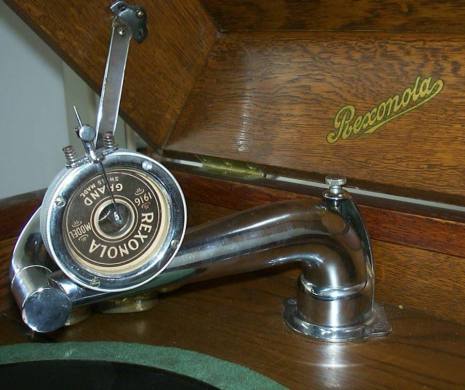
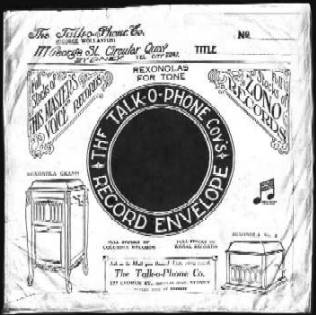
The Rexonola Picture Gallery
MODEL SHORTCUTS:
Please note that the complete range of Rexonola models is not yet featured. If you’d like your ‘Rex’ included, I'd be happy to receive email with info and images attached. Judging from original adverts and pictures submitted by owners, it's clear that Model configurations were fairly fluid in time. Variations to horn size (versus record storage), type of doors and hardware fitted, cabinet decoration, etc. seem to have occurred during a Model’s production life.
This page is graphics intensive and slow to load... Click some images to view higher quality versions...
Rexonola ‘Grand’ or Model No.1—‘top-of-the-line’ acoustic-era Rex...
The beautiful ‘Grand’ was the top of the range Rex in 1923, prior to the advent of electrical recording.... It featured selected hand-carved oak matched to the best available motor, sound-box and hardware. It also employed a larger ‘reflector sound chamber’ than its similar, but less fancy stablemates, the Models No. 2 & 4.
The hyperlinks below include a 1923 advertisement for the ‘Grand’ by Sydney’s Anthony Horderns & Co, ‘Universal Providers’.
[Rexonola Grand pictures: courtesy of Steve Pritchard]
The graphic below is taken from a c1925 Rexonola Catalogue. Note that by this time the ‘Grand’ or ‘No.1’ has lost its hand carved, curvy rear legs, these having been replaced with simple straight pillar types, as in the Model Nos. 2 & 4. The drop front door to the record compartment has been replaced by by twin vertical doors and the ornate carving to the base of the door has also disappeared.
[Scans on this page from photocopy of rare Rexonola Catalogue c1925: courtesy of Barry Poor]
Notably, the new No.1’s below no longer posess any of the rich hand carving of the earlier machines. Perhaps Jackson & Macdonald thought the need for a fancy, up-market line could now be filled by the newer ‘Period Models’.
Below, a December 1926 advertisement by Rexonola manufacturer Jackson & MacDonald, promotes the ‘New No.1’ with enlarged horn of new ‘Prismatic’ design. Note that this new machine is still fitted with the acoustic-era ‘Autophonic’ sound-box. Shortly after, in early 1927, full ‘Prismaphonic’ models started coming onto the market. I reckon the line drawing below of the ‘New No.1’ might be out of proportion—it portrays the machine’s elegant lines as very ‘jowly’... Pictured below is the deck of a ‘New No.1’, distinguished mainly by the presence of the new ‘Rexophonic’ speaker fitted to the tone-arm. Has that swan neck/ speaker assembly been accidentally refitted at some stage to the right-hand side of the tone-arm?
[New No.1 turntable deck picture: courtesy of Noel Campbell]
Rexonola Model No.2
The No.2 was similar to, but slightly larger than, the Models No.1 and No.4.
The instrument on the left is a 1916 model, interesting because it features doors to the horn instead of the more usual gothic style grille fitted to the second machine, a 1924 model. Both are finished in what Rexonola called ‘Golden Oak’. Considerable care was taken in timber selection and matching to best exploit the natural beauty of oak grain. The earlier machine has no wheel castors, perhaps someone removed them some time during the last 87 years...
[Rexonola No.2 pictures: courtesy of Lindsay Witherby & Tony Maher]
Below is a ‘Talk-o-Phone Company’ August 1926 advert for the Rexonola No.2 and the HMV / Victor ‘Bungalow’ Model...
Rexonola Model No.4, circa 1925
This machine is a gem, aesthetically and acoustically... It's lines, proportion and size all come together producing a fine appearance. It is fitted with a multi-spring motor and Rexonola ‘Grand Nickel Sound Box’ but a spare 1925 ‘Autophonic’ box is also shown sitting face-up near the turntable. The machine has excellent patination and is in original condition (except for the crimson grille-cloth). Oak Rexonolas were finished in either darker shades referred to as ‘Flemish’ or ‘fumed’ oak or as the lighter ‘golden’ or ‘mission’oak. Most models could also be had in ‘mahogany’—this was actually appropriately stained Queensland Maple.
Here are some links to 1920’s advertisements for the Rex No.4...
A large, dignified table design based on a Model No.2 according to the Jackson & Macdonald Catalogue and of the finest workmanship says the 1924 Anthony Hordern’s Catalogue—note the slight difference in dimensions and also two differing grille treatments. Why is the psuedo ‘mahogany’ model (really stained Queensland Maple) nearly £6 more expensive than units constructed from real fine old oak?
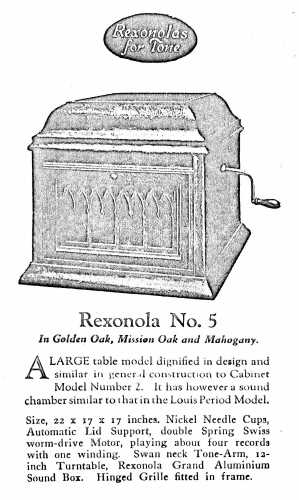
Popular mid-range table-top Rexonola. The 1923 catalogue issued by Sydney’s Anthony Horderns & Co, ‘Universal Providers’ and Rexonola’s own catalogue both describe this model well...
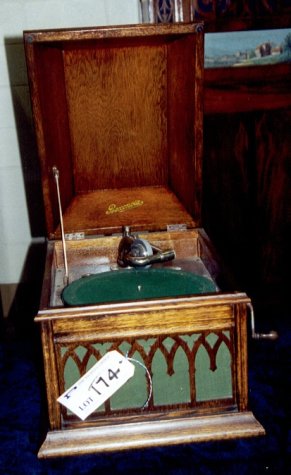
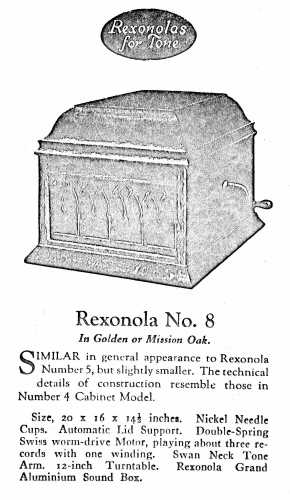
Very slightly smaller than the No.8 and fitted with either the ‘Aluminium Concert Sound Box’ or the nickel plated ‘Standard’:
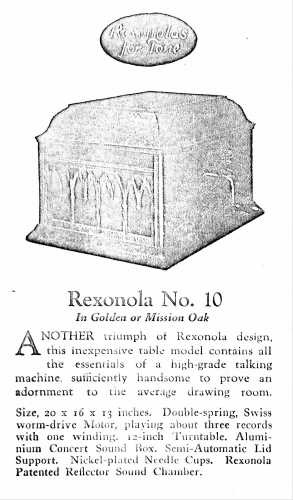
Getting cheaper but still attractive features... has a twelve inch turntable, double-spring motor, swan-neck tonearm, mid-range sound box and attractive figured oak cabinet...
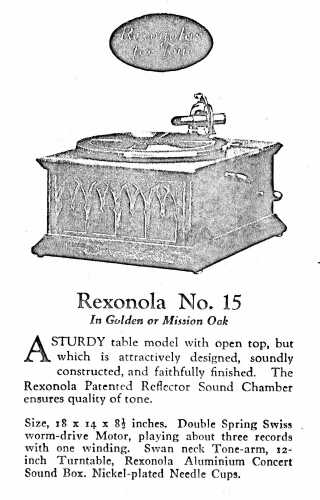
The second cheapest Rexonola made. Note the rigid tone-arms fitted with either ‘Standard’ (also referred to as the ‘Nickel Grand’) or a ‘Concert’ sound-box, according to vintage. Note the speed control knob located next to the crank fitting and the ‘Camp Phonograph’ decal which states ‘Rd No 1703’, a trademark / patent registration date I've seen on several Rexonolas. Don’t know what the story is with the 1920’s ‘CAMP’ trademark, but sure as eggs it aint what us 2005 citizens might think of!
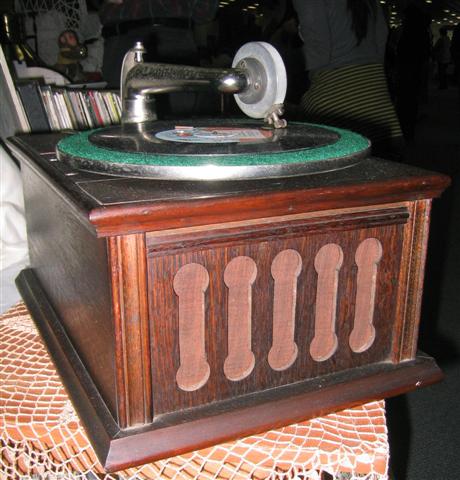
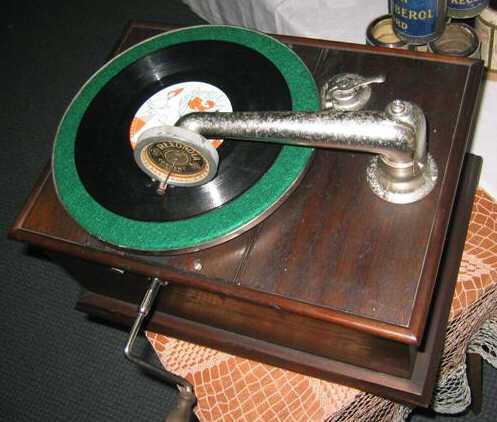
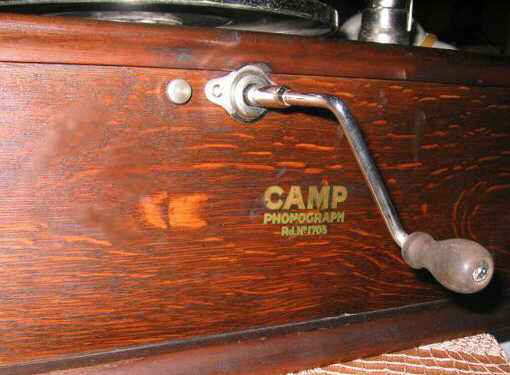
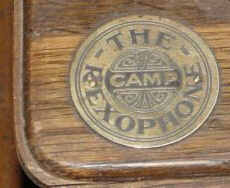
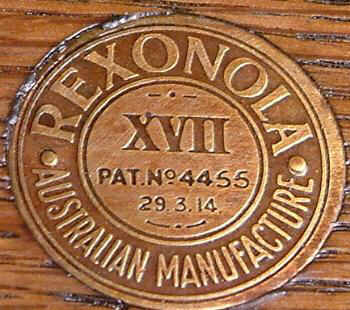
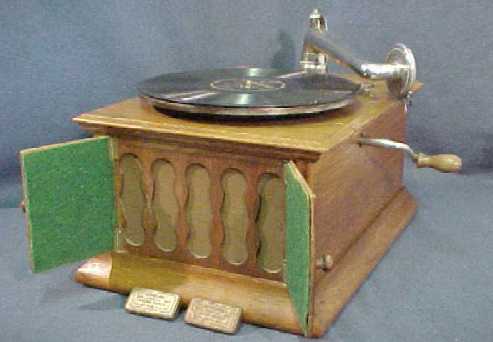
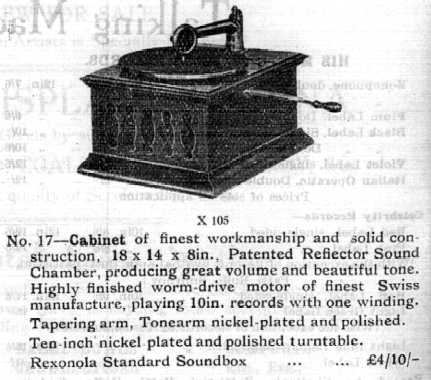
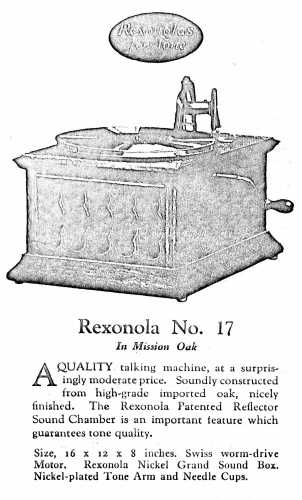
The cheapest Rexonola made... . slightly smaller and about £1 less expensive than the Model No.17. The advert describes a simple lid-less table-top machine, it lacks a decorative grille and has a simple open mouthed horn. Both models 17 and 18 use a 10" turntable, single spring simplified Thorens motor and rigid tone-arm fitted with a ‘Standard’ (also referred to as the ‘Rexonola Nickel Grand’) speaker—although, the example pictured is fitted with an ‘Alumimium Grand’ sound-box. The pictured example has had the nickel plated metalwork restored with ‘Galmet’ which gives a hammered bronze type finish.
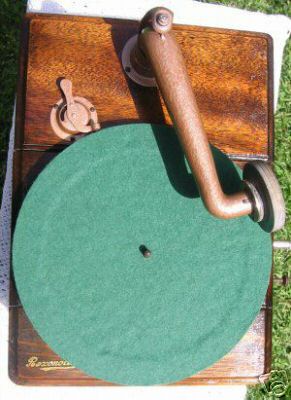

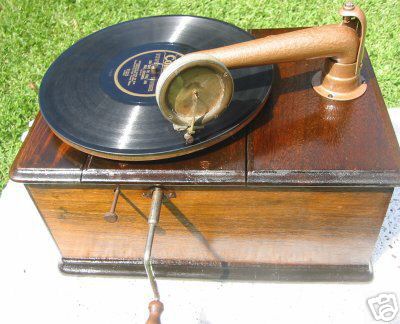
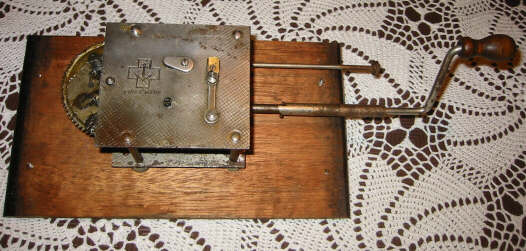
[Model 18 pictures: courtesy of Barry Poor]
Rexonola Model No.20 ‘Prismaphonic’
In November 1927 the Model No.20 ‘Prismaphonic’ with its attractively embellished cabinet, became the upmarket table-top Rexonola. Even though optimised for ‘new’ electrical recordings, the old-style ‘Autophonic’ speaker with mica diaphragm was still offered as an option, as in this J&M advertisement...
[Model 20 pictures: courtesy of Barry Poor]
Rexonola Model No.30 ‘Prismaphonic’
The Model No.30, introduced circa late 1927, was the least expensive of the floor standing cabinet range of ‘Prismaphonics’. The large ‘Prismatic Horn’ occupied most of the cabinet space with only a small compartment below the horn available for records (see link below). Therefore ‘Prismaphonics’ offered much reduced record storage compared to the old acoustic-era designs.
The line drawing advert illustrations of the ‘Prismaphonics’ give the impression of a three dimensional door treatment. In fact they are flat—the protruding effect is created by careful use of shaded staining and graining with routed grooves outlining the central shield-like decoration.
This pic links to the full page 1928 Model 30 advertisement...
Rexonola Model No.35 ‘Prismaphonic’
Follow the links to display detailed shots of the Model 35 and a full page advertisement from September 1929...
[Model 35 pictures: courtesy of Barry Poor]
Rexonola Model No.50 ‘Prismaphonic’
View full page 1928 Model 50 advertisement...
Rexonola Model No.55 ‘Prismaphonic’
Note the enormous ‘Prismatic’ horn fitted to the first machine in this March 1929 advertisement. The other images demonstrate how an alternative configuration, within the same cabinet, offered record storage albeit at the cost of a markedly smaller horn.
Rexonola Model No.60 ‘Prismaphonic’—Top-of-the-line in ’29!
In 1929 the ‘60’ was Rexonola’s
upmarket instrument. It features an enormous ‘Prismatic’
horn.
Read what Rexonola thought of their ‘60’ in this full page advert...
To discover if the ‘60’ really sounded as big as it looked, read a 1928 review...
Rexonola Jacobean Period Model
I haven’t seen one of these but the cabinet style is characteristic of the mid 1920’s taste for good quality reproduction Jacobean style furniture. By around 1925 the ‘Grand’ or ‘Model No.1’ seems to have been superceded as the up-market Rexonola by these two new ‘Period’ machines...
Again, I haven’t seen one... The cabinet revives French styles of the eighteenth century.
Rexonola ‘Bijou’ Console Model
Below is a May 1927 advertisement for the Rexonola ‘Bijou’. The style shouts ‘modern’, but in the pictures it seems the least attractive Rexonola ever produced. No doubt the actual machine, with its heavily accented oak finish, looked quite desirable. The ‘Bijou’ was also expensive—for the original purchase price of £26 in oak (or up to £32 in maple) you might have two Model No.4s or 30s. My guess is that not many ‘Bijous’ will have survived and the machine would now be quite rare...

‘Rexoports’—Rexonola
portables...
or
Home
Created: Michael Chapman & Peter Stephens, March 2003
Last edit: Wednesday, 18 September 2024 18:43